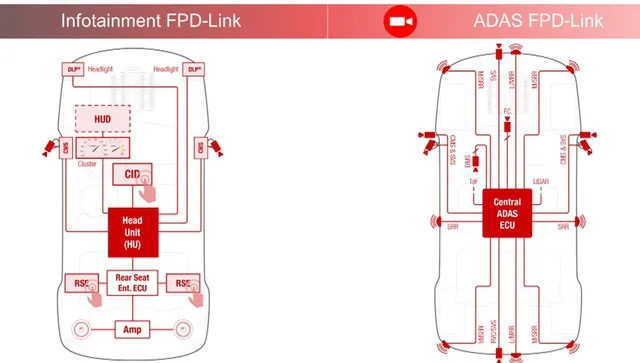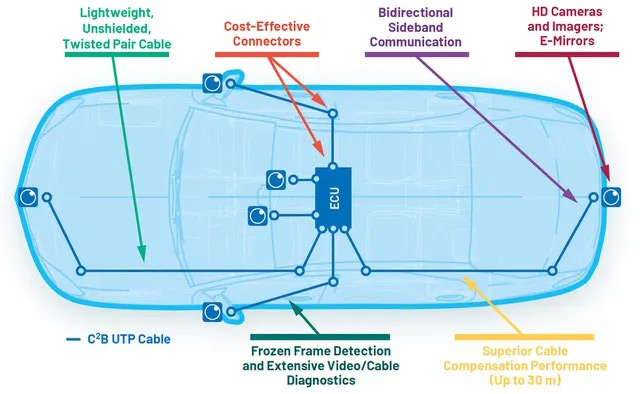Time:2024-11-08 Browse: 116
FPD-Link is an open standard that can be used without a license. It was originally developed by National Semiconductor and acquired by Texas Instruments (TI). The FPD-Link IV, the latest version, is a high-speed serializer/unstringer (SerDes) that enables high-bandwidth video transmission and audio support in vehicles.
The FPD-Link IV can drive multiple displays from a single serializer device, each of which is connected via a coaxial cable. It can support high-bandwidth automotive processors for displays with up to 8K UHD resolutions. Its high bandwidth and low latency make it suitable for circumnavigation camera systems, LiDAR, radar, etc.
Certain cameras in Advanced driver assistance systems (ADAS) must be synchronized so that frames captured by different cameras can be aligned in time. Hardware triggers or software synchronization implemented through FPD-Link IV can achieve this.
Using coaxial cables, FPD Link can transmit data and control signals up to 13 Gigabits per second (Gbps) and achieve video bandwidth of more than 25Gbps over two cables. The FPD-Link IV technology also supports Daisy chains and detachings to drive multiple displays using a single SoC interface (Figure 1).

Figure 1.FPD Link can support infotainment and ADAS systems (Image: Texas Instruments)
Designed by Analog Devices, the C2B delivers HD performance at a low cost by using unshielded twisted pair (UTP) cables instead of more expensive coaxial cables. Typical applications include automotive ADAS, surveillance cameras on buses, and general-purpose video delivery. A key focus of the C2B is to use existing low-cost UTP cabling to upgrade from SD cameras to HD cameras without changing the cabling.
The combination of multilevel signaling, internal filtering and optimized video coding provides electromagnetic interference resistance and reliable performance. It also includes a high-speed reverse channel for remote camera control. This signaling can reduce the cable bandwidth requirement by an order of magnitude, thus enabling UTP cabling.

Figure 2. Connectivity and sample functionality implemented by C2B (Image: Analog Devices)
Like C2B, AHL is designed to transmit high-definition video over UTP cables. Both are used for similar applications. Renesas Electronics has developed AHL and uses efficient video compression algorithms to transmit high-quality video data over low-bandwidth cables while minimizing latency.
The ability to simultaneously send control signals to the camera via the same UTP cable that transmits video data improves the performance of the AHL system and keeps costs low. The alway available control channel operates independently of the video stream and can be used to initialize camera Settings at startup and send I2C, GPIO, and interrupt commands to the camera during live video transmission (Figure 3).

Figure 3. Simplified representation of AHL signal highlighting I2C control channel (Image: Renesas Electronics)
FPD Link, C2B, and AHL are all viable options for automotive vision systems, but they vary in use cases, performance, and cost. To determine the best choice for a particular application, designers need to make trade-offs between latency, control signals, image quality, cabling simplicity, the ability to support Daisy chains and separations, and other factors.
Copyright © 2024 Shanghai Hongtong Electronic Co., Ltd.